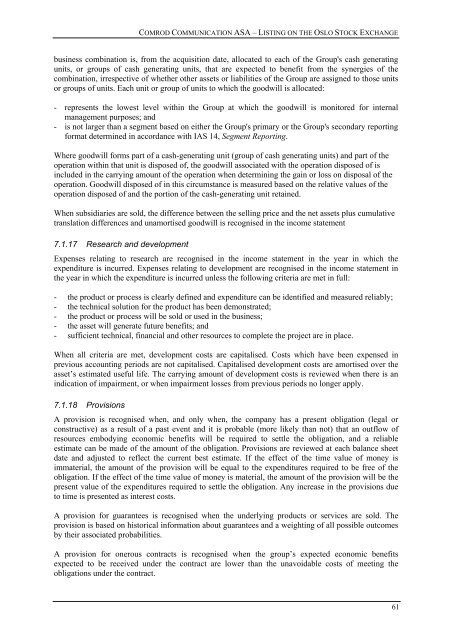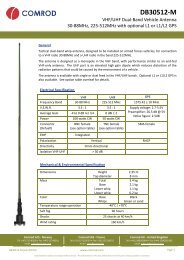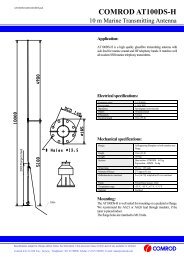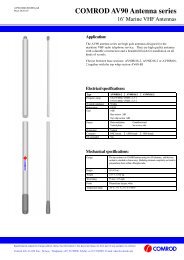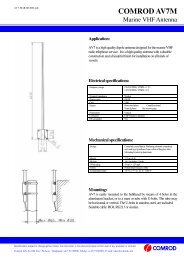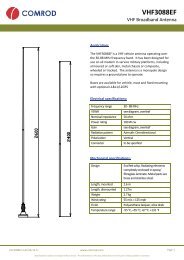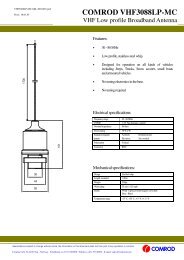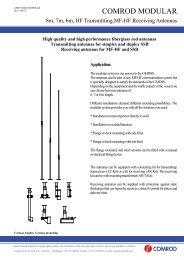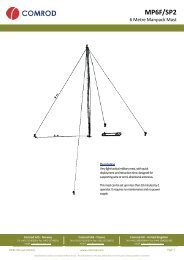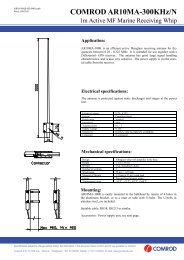English version - Hexagon Composites ASA
English version - Hexagon Composites ASA
English version - Hexagon Composites ASA
Create successful ePaper yourself
Turn your PDF publications into a flip-book with our unique Google optimized e-Paper software.
COMROD COMMUNICATION <strong>ASA</strong> – LISTING ON THE OSLO STOCK EXCHANGE<br />
business combination is, from the acquisition date, allocated to each of the Group's cash generating<br />
units, or groups of cash generating units, that are expected to benefit from the synergies of the<br />
combination, irrespective of whether other assets or liabilities of the Group are assigned to those units<br />
or groups of units. Each unit or group of units to which the goodwill is allocated:<br />
- represents the lowest level within the Group at which the goodwill is monitored for internal<br />
management purposes; and<br />
- is not larger than a segment based on either the Group's primary or the Group's secondary reporting<br />
format determined in accordance with IAS 14, Segment Reporting.<br />
Where goodwill forms part of a cash-generating unit (group of cash generating units) and part of the<br />
operation within that unit is disposed of, the goodwill associated with the operation disposed of is<br />
included in the carrying amount of the operation when determining the gain or loss on disposal of the<br />
operation. Goodwill disposed of in this circumstance is measured based on the relative values of the<br />
operation disposed of and the portion of the cash-generating unit retained.<br />
When subsidiaries are sold, the difference between the selling price and the net assets plus cumulative<br />
translation differences and unamortised goodwill is recognised in the income statement<br />
7.1.17 Research and development<br />
Expenses relating to research are recognised in the income statement in the year in which the<br />
expenditure is incurred. Expenses relating to development are recognised in the income statement in<br />
the year in which the expenditure is incurred unless the following criteria are met in full:<br />
- the product or process is clearly defined and expenditure can be identified and measured reliably;<br />
- the technical solution for the product has been demonstrated;<br />
- the product or process will be sold or used in the business;<br />
- the asset will generate future benefits; and<br />
- sufficient technical, financial and other resources to complete the project are in place.<br />
When all criteria are met, development costs are capitalised. Costs which have been expensed in<br />
previous accounting periods are not capitalised. Capitalised development costs are amortised over the<br />
asset’s estimated useful life. The carrying amount of development costs is reviewed when there is an<br />
indication of impairment, or when impairment losses from previous periods no longer apply.<br />
7.1.18 Provisions<br />
A provision is recognised when, and only when, the company has a present obligation (legal or<br />
constructive) as a result of a past event and it is probable (more likely than not) that an outflow of<br />
resources embodying economic benefits will be required to settle the obligation, and a reliable<br />
estimate can be made of the amount of the obligation. Provisions are reviewed at each balance sheet<br />
date and adjusted to reflect the current best estimate. If the effect of the time value of money is<br />
immaterial, the amount of the provision will be equal to the expenditures required to be free of the<br />
obligation. If the effect of the time value of money is material, the amount of the provision will be the<br />
present value of the expenditures required to settle the obligation. Any increase in the provisions due<br />
to time is presented as interest costs.<br />
A provision for guarantees is recognised when the underlying products or services are sold. The<br />
provision is based on historical information about guarantees and a weighting of all possible outcomes<br />
by their associated probabilities.<br />
A provision for onerous contracts is recognised when the group’s expected economic benefits<br />
expected to be received under the contract are lower than the unavoidable costs of meeting the<br />
obligations under the contract.<br />
61


